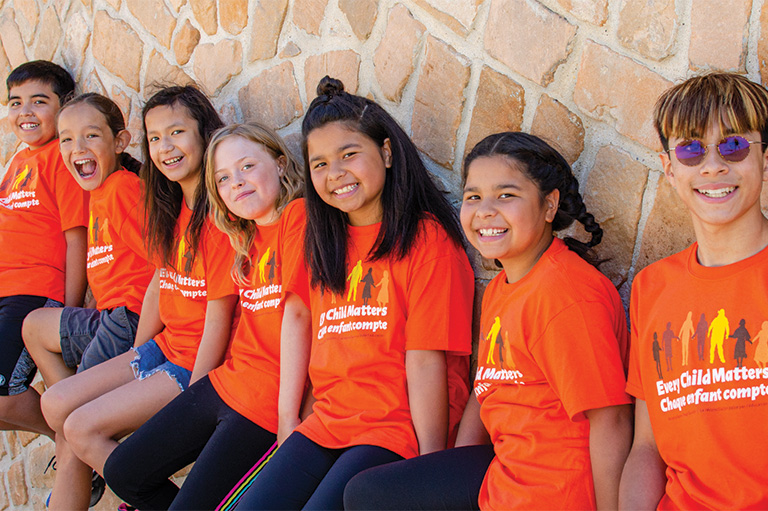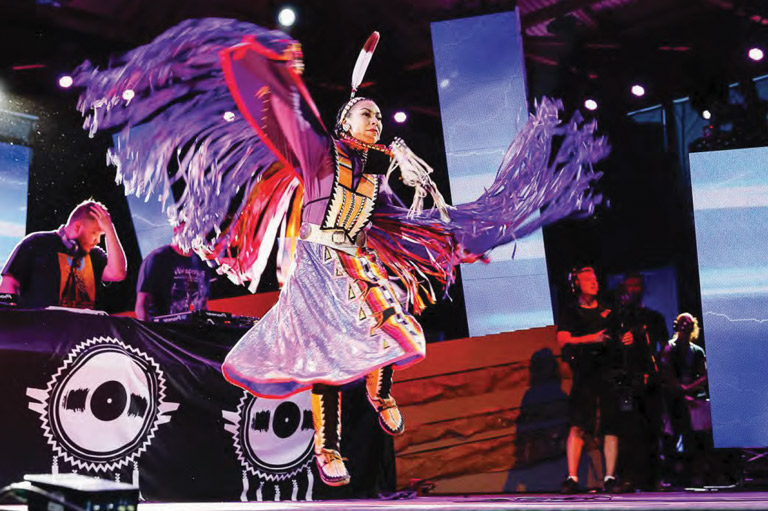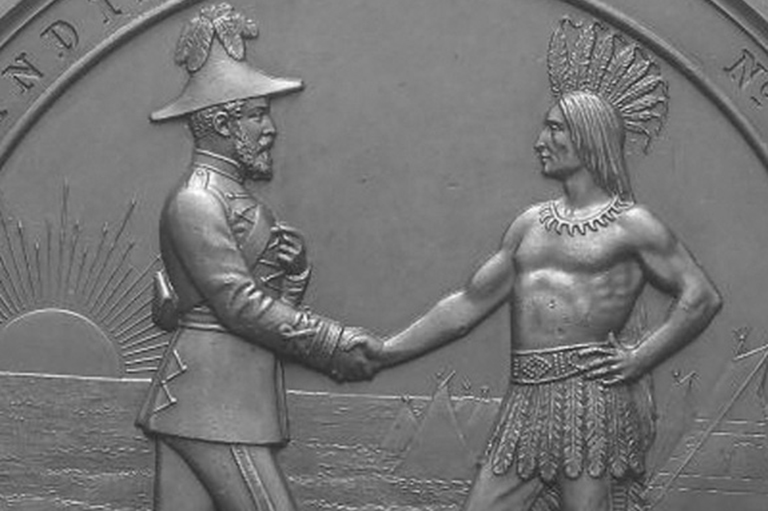Honesty: Taking Action
Grade Levels: 7/8, 9 (adaptable for students working at lower grade levels)
Subject Area: Social Studies/History/English Language Arts/Civis
Lesson Overview
In this lesson, students will take up the concepts of honesty and action. Specifically, students will learn about Indigenous youth who have taken action against the harms of colonialism. Students will assess the outcomes of individual and collective action, and design a personal plan for reconciliation in their own lives and communities. They will also learn how to navigate difficult conversations that sometimes occur when you stand up for what you believe in.
Time Required
4 lessons (60 minutes each)
Historical Thinking Concepts
- Use primary source evidence
- Identify continuity and change
- Analyze cause and consequence
- Take historical perspectives
- Understand the ethical dimension of historical interpretations
Learning Outcomes
Students will:
- Understand their roles/responsibilities in reconciliation;
- Identify some of the inequities that Indigenous children and youth experience;
- Discuss the incredible resiliency of Indigenous youth in the face of adversity;
- Assess and examine the impacts of individual and collective actions;
- Generate guidelines for navigating difficult conversations; and
- Design a reconciliation action plan.
Background Information
According to Statistics Canada (2016), one third of First Nations and Inuit peoples, and 22 % of Métis people are under 14 years old, and the youth population is increasing. This means that children and youth are both the present and future of their communities, and like all young people, they deserve to grow up safely in their homes and communities with opportunities, access to services, education, and culture (Blackstock, Bennet & Ng-A-Fook, 2018). Indigenous children and youth are often denied the basic services that most of us take for granted. Despite these incredible challenges, First Nation, Inuit, and Métis Youth are advocating for their rights, raising awareness, and rising up with strength and resilience. Their perseverance and strength have inspired non-Indigenous youth across Canada to take action in peaceful and sustained ways. Indeed, Shannen’s Dream has been called the “largest youth-driven movement in Canadian history” (Angus, 2015, p. 2).
The Lesson Activity
Lesson 1:
Part 1:
Show students the pictures of youth activists. Give them some time to look at the photographs and then ask the following questions: What do you see in the photos? What are the people in the photos doing and why? Have you seen any of them in the news or on YouTube?
Invite students to take a moment to “turn and talk” to a classmate about the youths in the photo.
Explain that each of these youth are leaders in their communities, taking on issues such as underfunding in education and other services on reserves, the high rate of suicide among Inuit youth, and leadership in Métis culture and rights. Each of these youth have had to engage in difficult conversations about their experiences due to the harms of colonialism in Canada. Let students know that they will have a chance to “meet” each of these youth leaders later in the lesson.
Part 2:
Ask students if they have ever spoken out against injustice or walked in support of something. Ask students to “think/pair/share” for a moment.
Discuss their responses, asking the questions: What does it take to stand up to something? How do you navigate difficult conversations with people who might not understand your position? What might be the causes and consequences of standing up for your beliefs (or of not standing up?)
Read the section on “Honesty” in the Every Child Matters magazine, either in small groups or aloud to your class. Discuss the statement, “Having the courage to talk about what you’re learning, how it’s impacting you, and what you want to change is powerful and courageous.”
Explain to students that learning the truths about Canadian history means being honest about our collective story, learning about residential schools, the Indian Act, and the ongoing inequities and oppressions that many Indigenous communities face. Being honest also means understanding our own privilege and using it in a respectful way to work against anti-Indigenous racisms. Brainstorm a list of ways that students can navigate difficult conversations with others. Post this list in the classroom.
End this lesson with a short clip from the National Film Board of Canada called Hi Ho Mistahey. Explain that legendary Indigenous filmmaker Alanis Obomsawin, who lives in Montreal, made this film. (Display her photo on the screen.) She has made over 50 films about Indigenous peoples in Canada and inequitable services.
Tell students that this clip is just over a minute long, and it features 12-year-old Summer Mudd, from Attawapiskat First Nation. In it, she is speaking at a news conference at a school in Ottawa, demanding that the government address underfunding to education on reserves.
Ask students to think about the honesty and courage that Summer had to stand up and speak.
Play clip (19:43-21:00 min)
Ensure you have time to address any feelings, questions, and/or comments students might have after the lesson.
Lessons 2 & 3:
Part 1:
Display these inquiry questions:
- What are some of the inequities Indigenous children and youth face and how are they overcoming these inequities with action?
- What are the lessons we can learn from them?
- How might we get involved in reconciliation in our own lives and communities?
Ask students to pick at least one and do a “quickwrite” (5 mins) about it. (Students who find it difficult to write quickly might draw or write joy notes.) Afterwards, invite a few students to share.
Ask students to organize themselves into groups of 4-5 (or organize groups yourself ahead of time, according to your preference/class needs). Explain that each group will do a mini-research project about one of the youths in the photographs (display the photographs on the screen) and then present their knowledge to the class, so that each youth is represented.
Display (and provide hardcopy handout, if needed) of the Questions/Guidelines to Support Student Research.
*Adapt as necessary to your class and learners. You might give certain groups certain questions, or less questions. Or, you may give some groups more in-depth questions.
Part 2:
Prior to this lesson, print out the pictures of each youth and display them on poster board/chart paper around the classroom, with their name written above their photo.
Each student group will present their mini-research project (5 mins). You may invite students to take jot notes as they listen to the presentations, depending on your class needs.
After the presentation, pass out a sticky note to each student and ask them to write down one thing they learned about the youth that they find inspiring. Collect sticky notes and put them on the appropriate poster board (or ask a student to do this).
At the end of the presentations, you will have a collection of student thinking around the room about each of the youth leaders.
Ask students to join you in a circle on the floor (if your students know how to participate in a circle discussion, this won’t need any explaining. If you don’t regularly use circles, you may want to try it out with your class before this lesson. This is a wonderful guide to establishing circles with your class.)
Pass around an object (a stone, a seashell etc.) and ask students these questions: What was the most inspiring part of learning about the youth leaders? What might you do in your own life to foster positive relationships and action toward reconciliation?
Lesson 4:
Recap the learning students have done so far by saying something such as: “In these lessons, we have witnessed the incredible strength and resilience of Indigenous youth in spite of so much adversity. Colonialism, Indian residential schools, the child welfare system, and chronic inequitable funding for education and health services have created a system of oppression in Canada for Indigenous youth. What do you think were the historical perspectives of the time when the policies for funding services for children on reserve were created? What are the perspectives now?” Discuss these important questions.
Go on to remind students that despite these injustices, youth leaders such as Shannen Koostachin, David Kawapit, Hannah Tooktoo, Mitch Case, Gabrielle Fayant, and Maatalii Okalik are rising up, demanding justice, and showing strong leadership. How might we use the lessons of their courage and honesty to take action ourselves?
Explain that students will have the opportunity to take what they have learned and design a reconciliation plan for themselves. They can work individually, with a partner, or in a small group. The idea is that they have a plan to take part in action by the end of the class.
Display the following links to these non-profit Indigenous-led organizations that are working towards reconciliation:
- First Nations Child and family Caring Society (Campaigns and resources for action around Shannen’s Dream, I am a Witness, Jordan’s Principle)
- Moosehide Campaign (violence against Indigenous women and children)
- Downie-Wenjack Fund (reconciliation between Indigenous and non-Indigenous peoples
- National Centre for Truth and Reconciliation’s Imagine-a-Canada (education for reconciliation).
Ask students to research one of the organizations and decide on a campaign they wish to engage in. Provide them with (and/or display) the Reconciliation Plan Guiding Questions to guide the creation of their plan.
Give students time to create a written plan. Make sure you leave enough time for students to share their plans if they want to.
Before the end of the lesson, discuss a reconciliACTION that your class or school community could take up. How might you go about teaching others in your school what you have learned in these lessons?
Make sure to follow-up in subsequent classes and invite students to share how their reconciliation work is going with the class.
Materials/Resources
- Access to internet and devices
- Photos of youth leaders
- Questions/Guidelines to Support Student Research
- Every Child Matters magazine
- Picture of Alanis Obomsawin
- Hi Ho Mistahey clip
- Sticky notes
- poster board
- chart paper
- markers
- printer
- item for circle
- circle guide
- Reconciliation Plan Guiding Questions
Assessment:
You might use the student’s reconciliation action plan as an assessment to understand how they are thinking about the concepts they learned throughout the lessons. You could also create a rubric for the mini-research project and assess students on research skills, group work etc. Finally, you can have students complete a self-assessment at the end of the lesson sequence.
Extension Activities
- Blackout Poetry: Write a Blackout Poetry using the TRC Calls to Action to illustrate inequities that many Indigenous children and youth face.
- Write a letter/email: Learn more about one of the Indigenous Youth that students “met” through their mini-research projects. Write the youth a letter, expressing what you understand about the inequities they face and the leadership that they have showed. Then, ACTUALLY mail or email your letter to them! The youth we met in this lesson were: Shannen Koostachin (send a letter to her family), David Kawapit, Hannah Tooktoo, and Mitch Case, Gabrielle Fayant, and Maatalii Okalik.
- Podcast/Blog: Contact one of the youth leaders and interview them for a podcast or blog that you create!
References
Angus, C. (2015). Children of the Broken Treaty: Canada’s lost promise and one girl’s dream. Regina, SK: University of Regina Press. Blackstock, C., Bennet, S. & Ng-A-Fook, N. (2018).
Just because we are Small doesn’t mean we stand tall: Reconciliation education in the elementary classroom. Unpublished SSHRC proposal. McGill University, Montreal, QC.
Statistics Canada. (2016). Aboriginal peoples in Canada: Key results from the 2016 Census.Retrieved from https://www150.statcan.gc.ca/n1/daily-quotidien/171025/dq171025a-eng.htm
There's more!
Themes associated with this article
Advertisement








